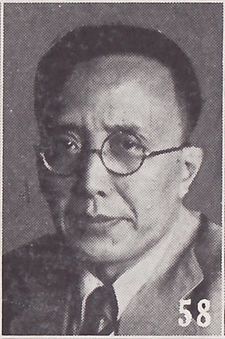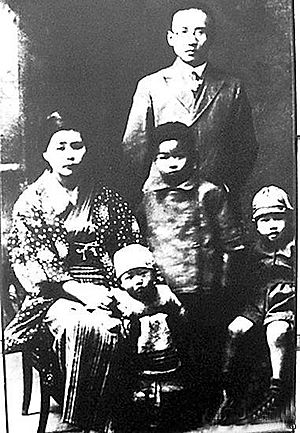Guo Moruo facts for kids
Quick facts for kids
Guo Moruo
|
|
|---|---|
| 郭沫若 | |
 |
|
| President of the University of Science and Technology of China | |
| In office 1958–1978 |
|
| Succeeded by | Yan Jici (1980) |
| Chairman of the Chinese Academy of Sciences | |
| In office 1949–1978 |
|
| Succeeded by | Fang Yi |
| Chairman of the China Federation of Literary and Art Circles | |
| In office 1949–1978 |
|
| Succeeded by | Zhou Yang |
| Personal details | |
| Born |
Guo Kaizhen (郭開貞)
16 November 1892 Leshan, Sichuan |
| Died | 12 June 1978 (aged 85) Beijing |
| Spouses |
Zhang Jinghua (1890–1980)
(m. 1912)Sato Tomiko (1894–1995)
(m. 1916)Yu Liqun (1916–1979)
(m. 1939) |
| Domestic partners | Yu Lizhen (1912–1937) Huang Dinghui (1907–2017) |
| Children | 8 sons and 3 daughters |
| Alma mater | Chengdu Shishi High School |
| Awards | 1948 Research Fellow of the Academia Sinica |
| Guo Moruo | |||||||||||||||||
|---|---|---|---|---|---|---|---|---|---|---|---|---|---|---|---|---|---|
| Chinese | 郭沫若 | ||||||||||||||||
|
|||||||||||||||||
Guo Moruo (Chinese: 郭沫若; pinyin: Guō Mòruò; Wade–Giles: Kuo Mo-jo; November 16, 1892 – June 12, 1978) was a famous Chinese writer, poet, historian, and archaeologist. He also held important government jobs. His courtesy name, which is a traditional Chinese name given to adults, was Dingtang (鼎堂).
Contents
Guo Moruo's Life Story
Early Life and Family
Guo Moruo was born as Guo Kaizhen on November 16, 1892. His hometown was Shawan, a small town in Sichuan Province, China. His family was involved in the river shipping business. This made them important and successful in their area.
Guo's father, Guo Mingxing, was a smart businessman. He traded in oils, liquor, and grain. He also worked as a Chinese medical doctor. This success helped the family buy more land and salt wells.
His mother came from a family of scholars. Her father was a jinshi, a high degree from the imperial exams. She married into the Guo family when she was fourteen.
Growing Up and School
Guo was the eighth child in his family. He started school very early, at four and a half years old. At first, he studied traditional Chinese books. Later, modern subjects like mathematics were added to his lessons.
When he was older, Guo went to public schools in Chengdu, the capital of Sichuan. His older brother, Guo Kaiwen, studied in Japan. He sent modern books and magazines home, which helped Guo Moruo learn about the world.
In 1906, Guo Moruo went to a new primary school in Jiading. He was a boarding student, living at the school. He was known for being very smart but also a bit of a troublemaker. He often stood up for other students. He was expelled and brought back a few times. Finally, he was permanently expelled in 1909.
Guo was happy about being expelled. It gave him a reason to go to Chengdu to continue his education. In 1912, he had an arranged marriage to Zhang Jinghua. But he regretted it right away. He left his wife five days later and never lived with her again.
Studying in Japan
In 1913, Guo Moruo went to Japan to study, just like his older brothers. He started at a school in Okayama. In 1916, he met Sato Tomiko, a Japanese nurse, and they fell in love. They lived together for 20 years and had five children.
Guo studied medicine at Kyushu Imperial University in Fukuoka starting in 1918. But he was more interested in literature. He read works by famous writers like Goethe and Rabindranath Tagore. In 1921, he published his first poetry book, The Goddesses. He also helped start the Creation Society in Shanghai. This group promoted new Chinese literature.
During the War Years
Guo Moruo joined the Chinese Communist Party in 1927. After a failed uprising, he had to flee back to Japan. He spent 10 years there studying ancient Chinese history. He wrote a book about old Chinese writings found on bones and bronze. In this book, he tried to show that ancient China was a "slave society," which was a popular idea in the Communist Party at the time.
In 1937, when the war with Japan began, Guo returned to China. He wanted to help fight against Japan. He tried to bring Sato Tomiko and their children to China, but the Japanese government stopped them. In 1939, he married Yu Liqun, an actress. After the war, Sato Tomiko came to China to find him. She was sad to learn he had started a new family.
As a Communist Leader
After the People's Republic of China was founded in 1949, Guo Moruo held many important government jobs. He was a very busy writer, creating poems, stories, plays, and historical books. He became the first President of the Chinese Academy of Sciences and led it until he died in 1978. He also became the first president of the University of Science & Technology of China (USTC). This university was created to train scientists and engineers.
For many years, Guo was seen as the top expert on Chinese history and culture. He guided ideas about art, education, and literature.
During the Cultural Revolution (a difficult political movement in China that started in 1966), Guo Moruo faced challenges. To protect himself and his family, he publicly criticized his own past works. He said they were wrong and should be destroyed. He also wrote poems praising Mao Zedong's wife, Jiang Qing, and the Cultural Revolution. He even spoke against former friends. Sadly, two of his sons, Guo Minying and Guo Shiying, died during this time due to persecution.
Despite these hardships, Guo survived the Cultural Revolution because of his strong loyalty to Mao. He regained his influence and enjoyed many benefits. He lived in a fancy house, had servants, and a special car. He also had a large collection of old furniture and interesting items.
In 1978, when he was very ill, Guo wrote a poem criticizing the "Gang of Four," a powerful political group that had fallen from power. He called Jiang Qing, Mao's wife, the "White-Boned Demon," a name from an old Chinese story.
Guo Moruo received the Stalin Peace Prize in 1951 for his work promoting peace.
Guo Moruo's Impact
Guo Moruo is highly respected in Chinese literature, history, and archaeology. Some people even compared him to the famous German writer Goethe.
However, he also faced criticism. Some people called him "shameless" because he sometimes changed his opinions to please powerful leaders like Mao Zedong. For example, he praised Mao's handwriting even when it had mistakes. During the Cultural Revolution, he wrote a book that praised one ancient poet, Li Bai, while putting down another, Du Fu. This was seen as a way to flatter Mao. His views on the "Gang of Four" also changed completely after they lost power.
Guo Moruo's Family
Guo Moruo had five children with Sato Tomiko and six children with Yu Liqun. In total, he had eight sons and three daughters.
With Sato Tomiko:
- Guo Hefu (born 1917): A chemist who helped start the Institute of Chemical Physics in China.
- Guo Bo (born 1920): A well-known architect and photographer. He helped design many modern buildings in Shanghai.
- Guo Fusheng
- Guo Shuyu: A Japanese language teacher who has passed away.
- Guo Zhihong
With Yu Liqun:
- Guo Hanying (born 1941): A theoretical physicist.
- Guo Shuying: She wrote a book about her father.
- Guo Shiying (1942 - 1968): He was a philosophy student. He faced difficult times during the Cultural Revolution and died at age 26.
- Guo Minying (1943 - 1967): He also died during the Cultural Revolution.
- Guo Pingying
- Guo Jianying (born 1953)
Places to Remember Guo Moruo
- Guo Moruo's home in Beijing, near Shicha Lake, is now a museum. He lived there with his second wife, Yu Liqun.
- The house where Guo and Sato Tomiko lived in Ichikawa, Japan, is also a museum. Because of this connection, Ichikawa became a sister city with Leshan, Guo's hometown, in 1981.
Other Writings and Translations
Guo Moruo translated many important books into Chinese. These include:
- The Sorrows of Young Werther by Goethe (1922)
- Virgin Soil by Ivan Turgenev (1925)
- Wallenstein by Schiller (1926)
- Thus Spake Zarathustra by Friedrich Nietzsche (1928)
- Faust, Part I by Goethe (1928)
- The Jungle by Upton Sinclair (1929)
- Capital by Karl Marx (1931)
- War and Peace by Leo Tolstoy (1935)
See also
 In Spanish: Guo Moruo para niños
In Spanish: Guo Moruo para niños



